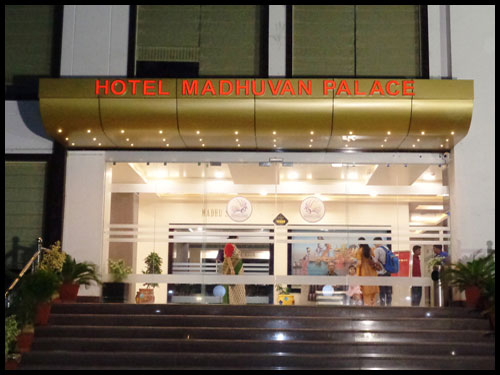
About to Madhuvan Palace
Hotel Madhuvan Palace, Hotels and Resorts represents a collection of distinct, upscale hotels and resorts known for its central locations and quality throughout the world. An elegant and welcoming ambience makes it easy for guests to focus on work as well as play. Discover our unique tales steeped in deep-rooted origins and celebrate local traditions as we bring our heritage to life.
Affiliate Member Programme
Madhuvan Palace and Resorts Affiliate Programme is designed for independent hotels that share our values and business philosophy.
We offer our Affiliate Hotels the possibility to benefit from our worldwide sales & marketing expertise, Hotel continues to retain its individuality.
We offer our Affiliate Hotels the possibility to benefit from our worldwide sales & marketing expertise, Hotel continues to retain its individuality.
About Varanasi
Varanasi also known as Benares, Banaras, or Kashi, is a NorthIndian city on the banks of the Ganges in Uttar Pradesh, India 320 kilometres (200 mi) south-east of the state capital, Lucknow and 121 kilometres (75 mi) east of Allahabad. Varanasi is one of the oldest continuously inhabited cities in the world. The spiritual capital of India, it is the holiest of the seven sacred cities (Sapta Puri) in Hinduism and Jainism, and played an important role in the development of Buddhism. Varanasi lies along National Highway 2, which connects it to Kolkata, Kanpur,Agra, and Delhi, and is served by Varanasi Junction and Lal Bahadur Shastri International Airport.
Varanasi grew as an important industrial centre, famous for its muslim and silk fabrics, perfumes, ivory works, and sculpture. Buddha is believed to have founded Buddhism here around 528 BC when he gave his first sermon, "The Setting in Motion of the Wheel of Dharma", at nearby Sarnath. The city's religious importance continued to grow in the 8th century, when Adi Shankara established the worship of Shiva as an official sect of Varanasi. Despite the Muslim rule, Varanasi remained the centre of activity for Hindu intellectuals and theologians during the Middle Ages, which further contributed to its reputation as a cultural centre of religion and education. Several major figures of the Bhakti movement were born in Varanasi, including Kabir and Ravidas. Guru Nanak Dev visited Varanasi for Shivratri in 1507, a trip that played a large role in the founding of Sikhism. In the 16th century, Varanasi experienced a cultural revival under the Muslim Mughal emperor Akbar who invested in the city, and built two large temples dedicated to Shiva and Vishnu, though much of modern Varanasi was built during the 18th century, by the Maratha and Bhumihar kings. The kingdom of Benares was given official status by the Mughals in 1737, and continued as a dynasty-governed area until Indian independence in 1947. The city is governed by the Varanasi Nagar Nigam (Municipal Corporation) and is represented in the Parliament of India by the current Prime Minister of India Narendra Modi, who won the Lok Sabha elections in 2014 by a huge margin. Silk weaving, carpets and crafts and tourism employ a significant number of the local population, as do the Diesel Locomotive Works and Bharat Heavy Electricals Limited. Varanasi Hospital was established in 1964.
Varanasi has been a cultural centre of North India for several thousand years, and is closely associated with the Ganges. Hindus believe that death in the city will bring salvation, making it a major centre for pilgrimage. The city is known worldwide for its many ghats, embankments made in steps of stone slabs along the river bank where pilgrims perform ritual ablutions. Of particular note are the Dashashwamedh Ghat, the Manikarnika Ghat, the Panchganga Ghat, and the Harishchandra Ghat, where Hindus cremate their dead. The Ramnagar Fort, near the eastern bank of the Ganges, was built in the 18th century in the Mughal style of architecture with carved balconies, open courtyards, and scenic pavilions. Among the estimated 23,000 temples in Varanasi are Kashi Vishwanath Temple of Shiva, the Sankat Mochan Hanuman Temple, and the Durga Temple. The Kashi Naresh (Maharaja of Kashi) is the chief cultural patron of Varanasi, and an essential part of all religious celebrations. An educational and musical centre, many prominent Indian philosophers, poets, writers, and musicians live or have lived in the city, and it was the place where the Benares Gharana form of Hindustani classical music was developed. One of Asia's largest residential universities is Banaras Hindu University (BHU). The Hindi-language nationalist newspaper, Aj, was first published in 1920.
 Etymology
Etymology
The name Varanasi possibly originates from the names of the two rivers from north and south: Varuna, still flowing in Varanasi, and Asi, a small stream near Assi Ghat. The old city is located on the north shores of the Ganges, bounded by its two tributaries: Varuna and Asi. Throughout the ages, Varanasi has been known by many names including Kāśī or Kashi (used by pilgrims dating from Buddha's days), Kāśikā (Sanskrit: "the shining one"), Avimukta (Sanskrit: "never forsaken" by Shiva), Ānandavana (Sanskrit: the forest of bliss), and Rudravāsa (Sanskrit: the place where Rudra/Śiva resides).
In the Rigveda, an ancient Indian sacred collection of Vedic Sanskrit hymns, the city is referred to as Kasi or Kashi, the "luminous city as an eminent seat of learning". The name Kāśī is also mentioned in the Skanda Purana. In one verse, Shiva says, "The three worlds form one city of mine, and Kāśī is my royal palace therein." The name Kashi may be translated as "City of Light".
 History
History
According to legend, Varanasi was founded by the god Shiva. The Pandavas, the heroes of the Hindu epic Mahabharata are also stated to have visit the city in search of Shiva to atone for their sin of fratricide and Brāhmanahatya that they had committed during the climactic Kurukshetra War. It is regarded as one of seven holy cities which can provide Moksha; Ayodhyā, Mathurā, Gayā, Kaśī, Kañchi, Avantikā, and Dwārāvatī are the seven cities known as the givers of liberation.
 Archaeological evidence
Archaeological evidence
Archaeological evidence of the earliest known settlements around Varanasi in the Ganges valley suggest that they began in the 11th or 12th century BC, placing it among the world's oldest continually inhabited cities. These archaeological remains suggest that the Varanasi area was populated by Vedic people. However, the oldest known text referencing the city, the Atharvaveda, which dates to approximately the same period, suggests that the area was populated by indigenous tribes. It is possible that archaeological evidence of these previous inhabitants has yet to be discovered. Recent excavations at Aktha and Ramnagar, two sites very near to Varanasi, show them to be from 1800 BC, suggesting Varanasi was also inhabited by this time.
 Ancient period
Ancient period
Varanasi grew as an important industrial centre, famous for its muslim and silk fabrics, perfumes, ivory works, and sculpture. During the time of Gautama Buddha, Varanasi was the capital of the Kingdom of Kashi. The Buddha is believed to have founded Buddhism here around 528 BC when he gave his first sermon, "The Setting in Motion of the Wheel of Dharma", at nearby Sarnath. The celebrated Chinese traveller Xuanzang, also known as Hiuen Tsiang, who visited the city around 635 AD, attested that the city was a centre of religious and artistic activities, and that it extended for about 5 kilometres (3.1 mi) along the western bank of the Ganges. When Xuanzang, visited Varanasi in the 7th century, he named it "Polonisse" and wrote that the city had some 30 temples with about 30 monks. The city's religious importance continued to grow in the 8th century, when Adi Shankara established the worship of Shiva as an official sect of Varanasi.

The city of Varanasi is situated along the west bank of the Ganges in the north Indian state of Uttar Pradesh. Called Benaras by the British, Varanasi is an important pilgrimage centre for the Hindus. The city finds mention in the great epics of Mahabharata and Ramayana. It was a flourishing trade center when Buddha came to Sarnath, about 10 kilometres away, to preach his first sermon in 500 BC. The renowned American novelist Mark Twain once wrote, "Benaras is older than history, older than tradition, older even than legend and looks twice as old as all of them put together." Right from the ancient times, Varanasi has stood as a symbol of Hindu renaissance and preserved the rituals and traditions of Hindu philosophy. Down the ages, pilgrims from distant lands have come to Varanasi in search of divine blessings.
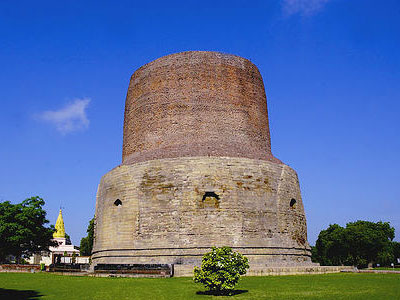 SARNATH
SARNATH
Sarnath, 10 km from Varanasi, where the Buddha preached his first sermon in the Deer Park, contains the most impressive remains, as well as a modem temple. The Dharmarajika, Chaukhandi and Dharnek stupas are outstanding. There are also the remains of a monastery, and the beautifully polished Lion Capital of Ashoka. Sarnath contains a rich library and at the Mula gandha Kutir Vihara there are excellent frescoes by Kosetsu Nosu. The Sarnath Museum, not far from the site, contains some of the finest specimens of Buddhist sculpture. At all centers of Buddhist worship, the Vaisakha (April-May) full moon is observed as the anniversary of three important events - the Buddha's birth, Enlightenment and death, while the Asadh (July - August) full moon is observed as the anniversary of his first sermon. Sarnath is one of the four most important Bhuddhist pilgrimage centres of India. Bhudda, the great sage , after attaining enlightenment (Bhudda-hood) at Bodh Gaya came to Sarnath and delivered his first sermon to five disciples (i.e. Kaundinya, Bashpa, Bhadrika, ahanaman and Ashvajit) for redeeming humanity. It is this place where foundation of a new order of monks (Sangha) and a new order of religious doctrine (Dhamma) was laid. Sarnath is also sacred to the Jains because they look upon it as the site of asceticism and death of Shreyamshanath, the 11th Trithanka
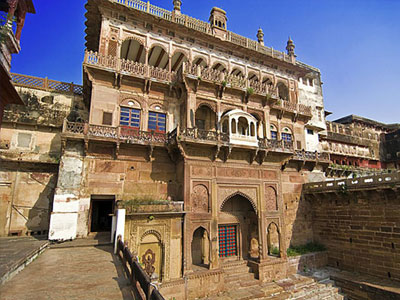 RAMNAGAR FORT
RAMNAGAR FORT
The Ramnagar fort lies about 14 km. from Varanasi and is situated on the opposite bank of river Ganga. It is the ancestral home of the Maharaja of Banaras. Maharaja Balwant Singh built this fort-palace in the eighteenth century. The fort is built in red sandstone. The Ramnagar fort has a temple and a museum within the grounds and the temple is dedicated to Ved Vyasa, who wrote Mahabharata, the great Indian epic. Legends have it that Ved Vyasa stayed here for a brief period. The Ramnagar fort houses a museum displaying the Royal collection which includes vintage Cars, Royal palkies, an armory of swords and old guns, ivory work and antique clocks. The Durga Temple and Chhinnamastika Temple are also Located at Ramnagar. A temple of Dakshin Mukhi Hanuman is there. Inside the giant walls of the Ramnagar fort-palace, there is a big clock. This clock not only displays year, month, week and day but also astronomical facts about the sun, moon and constellation of stars. An interesting array of ornate palanquins, gold-plated howdahs and weapons are some of the artifacts on display in the Ramnagar fort-palace museum
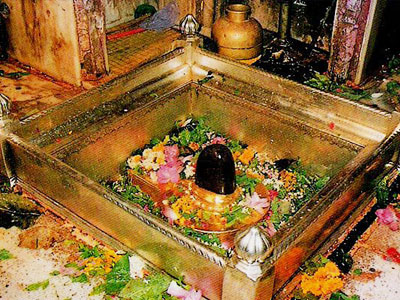 KASHI VISHWANATH TEMPLE
KASHI VISHWANATH TEMPLE
Also known as the Golden Temple, it is dedicated to Lord shiva, the presiding deity of the city. Varanasi is Said to be the point at which the first jyotirlinga, the fiery pillar of light by which shiva manifested has supremacy over others gods, broke through the Earth's crust and flared towards the heavens. More than the Gaths and even the Ganga, the Shivalinga installed in the temple remains the devotional focus of Varanasi. Standing on the western bank of India's holiest river Ganges, Varanasi is the oldest surviving city of the world and the cultural capital of India. It is in the heart of this city that there stands in its fullest majesty the Kashi Vishwanath Temple in which is enshrined the Jyotirlinga of Shiva, Vishweshwara or Vishwanatha. Here gravitate the teeming millions of India to seek benediction and spiritual peace by the darshan of this Jyotirlinga which confers liberation from the bondages of maya and the inexorable entanglements of the world. A simple glimpse of the Jyotirlinga is a soul-cleansing experience that transforms life and puts it on the path of knowledge and bhakti. Vishweshwara Jyotirlinga has a very special and unique significance in the spiritual history of India. Tradition has it that the merits earned by the darshan of other jyotirlinga scattered in various parts of India accrue to devotee by a single visit to Kashi Vishwanath Temple. Deeply and intimately implanted in the Hindu mind, the Kashi Vishwanath Temple has been a living embodinent of our timeless cultural traditions and highest spiritual values. The Temple has been visited by all great saints- Adi Shankaracharya, Ramkrishna Paramhansa, Swami Vivekanand, Goswami Tulsidas, Maharshi Dayanand Saraswati, Gurunanak and several other spiritual personalities. The Kashi Vishwanath Temple attracts visitors not only from India but abroad as well and thereby symbolises man's desire to live in peace snd harmony with one another. Vishwanath being a supreme repository of this spiritual truth thus strengthens the bonds of universal brotherhood and fellow feeling at the national as well as global levels. On January 28, 1983 the Temple was taken over by the Govt. of Uttar Pradesh and it's management ever since stands entrusted to a Trust with Dr. Vibhuti Narayan Singh. Former Kashi Naresh, as president and an Executive Committee with Divisional Commissioner as Chairman. The Temple in the present shape was built way back in 1780 by Late Maharani Ahilya Bai Holkar of Indore. In the year 1785 a Naubatkhana was built up in front of the Temple by the then Collector Mohd. Ibrahim Khan at the instance of Governor General Warren Hastings. In 1839, Two domes of the Temple were covered by gold donated by Punjab Kesari Maharaja Ranjeet Singh. Third dome but was remained uncovered, Ministry of cultures & Religious affairs of U.P. Govt. took keen interest for gold plating of third dome of Temple.
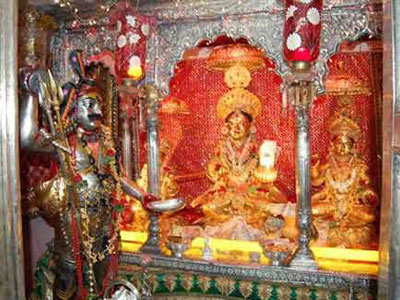 ANNAPURNA TEMPLE
ANNAPURNA TEMPLE
Near the Kashi Vishwanath temple, there is a nice temple of Devi Annapurna , believed as the "Godess of Fooding".
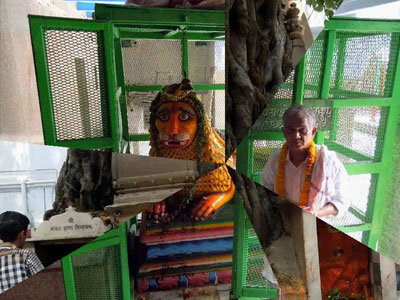 SANKATHA TEMPLE
SANKATHA TEMPLE
Near the Sindhia Ghat , there is a important temple of "Godess of Remedy" Devi Sankatha. Inside its premises there is a huge statue of a Lion. Also there is nine temples of nine planets nearby to this temple.
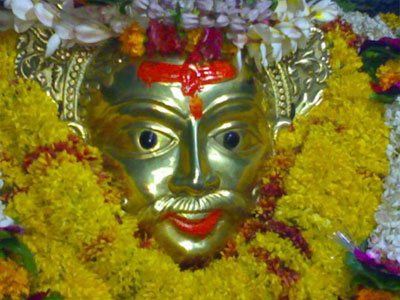 KALBHAIRAV TEMPLE
KALBHAIRAV TEMPLE
It is the ancient temple of Varanasi near the Head Post Office, VishesharGanj. God KalBhairav is believed as "Kotwal Of Varanasi" , without his permission no one can stay in Kashi.
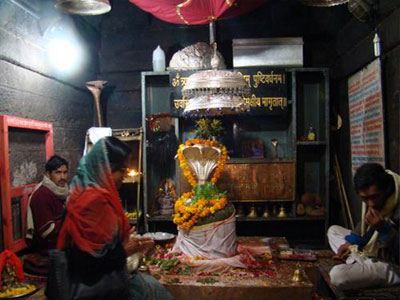 MRITUNJAY MAHADEV TEMPLE
MRITUNJAY MAHADEV TEMPLE
On the route of Daranagar to Kalbhairav temple this temple of Lord Shiva is situated . Just besides this temple there is a Well of much religious importance , whose water is said to be mixture of several underground streams and good for eliminating several diseases.
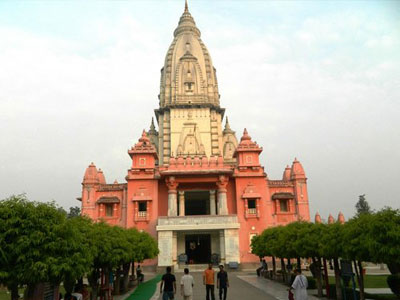 NEW VISHWANATH TEMPLE
NEW VISHWANATH TEMPLE
Situated in the premises of Banaras Hindu University, a modern place of worship planned by Pandit Malviya and built by the Birlas. Open to all, irrespective of caste or creed.
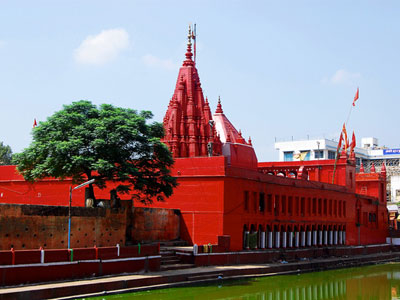 DURGA TEMPLE
DURGA TEMPLE
Commonly called the 'Monkey temple', it was built in the 18th century. Although it is one of the best-known temple. There is nice stonework done of the temple , it is the nice example of NAGRA Shilp. Godess DURGA is believed as the symbol of Strength and Power which govern the entire world. There is a pond adjacent to the temple called "Durgakund".
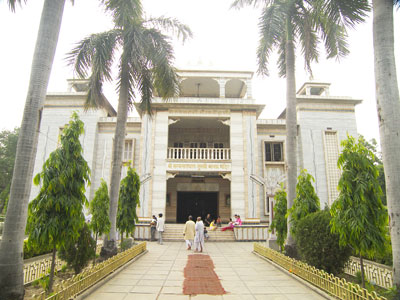 TULSI MANAS TEMPLE
TULSI MANAS TEMPLE
Constructed by family of Varanasi, this modern temple is dedicated to Lord Rama. It is situated at the place Where Tulisdas, the great medieval seer, lived and wrote the epic "Shri Ramcharitmanas", which narrates the life of Lord Rama, the hero of the Ramayana. Verses from Tulidas's epic are inscribed on the walls. It is just nearby to Durga Temple.
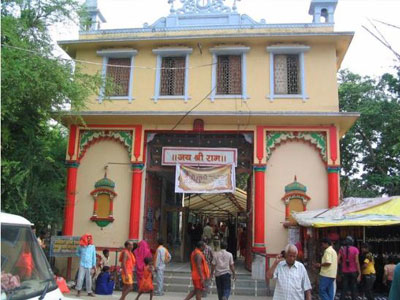 SANKAT MOCHAN TEMPLE
SANKAT MOCHAN TEMPLE
Besides the Assi river stream, on the way of Durga Temple to Banaras Hindu Temple this well known temple of Lord Hanuman is situated. Lord Hanuman is also known as "Sankatmochan" the god who protects from the troubles. This temple is founded by Goswami Tulsidas. This temple is also known as "Monkey" temple, as lot of monkeys are there inside the premises.
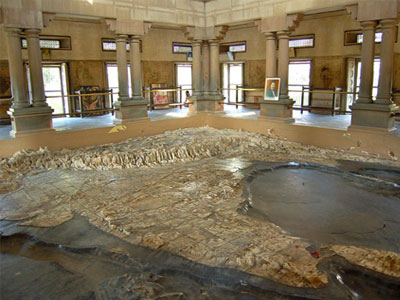 BHARAT MATA TEMPLE
BHARAT MATA TEMPLE
This Temple was inaugurated by Mahatma Gandhi in 1936 and houses one perfect relief maps of India carved out of marble.The Temple was gifted by the nationalists Babu Shiv Prasad Gupta (Barat Ratana ) and shri Durga Prasad Khatri, leading numismatists and antiquarians.
Varanasi grew as an important industrial centre, famous for its muslim and silk fabrics, perfumes, ivory works, and sculpture. Buddha is believed to have founded Buddhism here around 528 BC when he gave his first sermon, "The Setting in Motion of the Wheel of Dharma", at nearby Sarnath. The city's religious importance continued to grow in the 8th century, when Adi Shankara established the worship of Shiva as an official sect of Varanasi. Despite the Muslim rule, Varanasi remained the centre of activity for Hindu intellectuals and theologians during the Middle Ages, which further contributed to its reputation as a cultural centre of religion and education. Several major figures of the Bhakti movement were born in Varanasi, including Kabir and Ravidas. Guru Nanak Dev visited Varanasi for Shivratri in 1507, a trip that played a large role in the founding of Sikhism. In the 16th century, Varanasi experienced a cultural revival under the Muslim Mughal emperor Akbar who invested in the city, and built two large temples dedicated to Shiva and Vishnu, though much of modern Varanasi was built during the 18th century, by the Maratha and Bhumihar kings. The kingdom of Benares was given official status by the Mughals in 1737, and continued as a dynasty-governed area until Indian independence in 1947. The city is governed by the Varanasi Nagar Nigam (Municipal Corporation) and is represented in the Parliament of India by the current Prime Minister of India Narendra Modi, who won the Lok Sabha elections in 2014 by a huge margin. Silk weaving, carpets and crafts and tourism employ a significant number of the local population, as do the Diesel Locomotive Works and Bharat Heavy Electricals Limited. Varanasi Hospital was established in 1964.
Varanasi has been a cultural centre of North India for several thousand years, and is closely associated with the Ganges. Hindus believe that death in the city will bring salvation, making it a major centre for pilgrimage. The city is known worldwide for its many ghats, embankments made in steps of stone slabs along the river bank where pilgrims perform ritual ablutions. Of particular note are the Dashashwamedh Ghat, the Manikarnika Ghat, the Panchganga Ghat, and the Harishchandra Ghat, where Hindus cremate their dead. The Ramnagar Fort, near the eastern bank of the Ganges, was built in the 18th century in the Mughal style of architecture with carved balconies, open courtyards, and scenic pavilions. Among the estimated 23,000 temples in Varanasi are Kashi Vishwanath Temple of Shiva, the Sankat Mochan Hanuman Temple, and the Durga Temple. The Kashi Naresh (Maharaja of Kashi) is the chief cultural patron of Varanasi, and an essential part of all religious celebrations. An educational and musical centre, many prominent Indian philosophers, poets, writers, and musicians live or have lived in the city, and it was the place where the Benares Gharana form of Hindustani classical music was developed. One of Asia's largest residential universities is Banaras Hindu University (BHU). The Hindi-language nationalist newspaper, Aj, was first published in 1920.
The name Varanasi possibly originates from the names of the two rivers from north and south: Varuna, still flowing in Varanasi, and Asi, a small stream near Assi Ghat. The old city is located on the north shores of the Ganges, bounded by its two tributaries: Varuna and Asi. Throughout the ages, Varanasi has been known by many names including Kāśī or Kashi (used by pilgrims dating from Buddha's days), Kāśikā (Sanskrit: "the shining one"), Avimukta (Sanskrit: "never forsaken" by Shiva), Ānandavana (Sanskrit: the forest of bliss), and Rudravāsa (Sanskrit: the place where Rudra/Śiva resides).
In the Rigveda, an ancient Indian sacred collection of Vedic Sanskrit hymns, the city is referred to as Kasi or Kashi, the "luminous city as an eminent seat of learning". The name Kāśī is also mentioned in the Skanda Purana. In one verse, Shiva says, "The three worlds form one city of mine, and Kāśī is my royal palace therein." The name Kashi may be translated as "City of Light".
According to legend, Varanasi was founded by the god Shiva. The Pandavas, the heroes of the Hindu epic Mahabharata are also stated to have visit the city in search of Shiva to atone for their sin of fratricide and Brāhmanahatya that they had committed during the climactic Kurukshetra War. It is regarded as one of seven holy cities which can provide Moksha; Ayodhyā, Mathurā, Gayā, Kaśī, Kañchi, Avantikā, and Dwārāvatī are the seven cities known as the givers of liberation.
Archaeological evidence of the earliest known settlements around Varanasi in the Ganges valley suggest that they began in the 11th or 12th century BC, placing it among the world's oldest continually inhabited cities. These archaeological remains suggest that the Varanasi area was populated by Vedic people. However, the oldest known text referencing the city, the Atharvaveda, which dates to approximately the same period, suggests that the area was populated by indigenous tribes. It is possible that archaeological evidence of these previous inhabitants has yet to be discovered. Recent excavations at Aktha and Ramnagar, two sites very near to Varanasi, show them to be from 1800 BC, suggesting Varanasi was also inhabited by this time.
Varanasi grew as an important industrial centre, famous for its muslim and silk fabrics, perfumes, ivory works, and sculpture. During the time of Gautama Buddha, Varanasi was the capital of the Kingdom of Kashi. The Buddha is believed to have founded Buddhism here around 528 BC when he gave his first sermon, "The Setting in Motion of the Wheel of Dharma", at nearby Sarnath. The celebrated Chinese traveller Xuanzang, also known as Hiuen Tsiang, who visited the city around 635 AD, attested that the city was a centre of religious and artistic activities, and that it extended for about 5 kilometres (3.1 mi) along the western bank of the Ganges. When Xuanzang, visited Varanasi in the 7th century, he named it "Polonisse" and wrote that the city had some 30 temples with about 30 monks. The city's religious importance continued to grow in the 8th century, when Adi Shankara established the worship of Shiva as an official sect of Varanasi.

The city of Varanasi is situated along the west bank of the Ganges in the north Indian state of Uttar Pradesh. Called Benaras by the British, Varanasi is an important pilgrimage centre for the Hindus. The city finds mention in the great epics of Mahabharata and Ramayana. It was a flourishing trade center when Buddha came to Sarnath, about 10 kilometres away, to preach his first sermon in 500 BC. The renowned American novelist Mark Twain once wrote, "Benaras is older than history, older than tradition, older even than legend and looks twice as old as all of them put together." Right from the ancient times, Varanasi has stood as a symbol of Hindu renaissance and preserved the rituals and traditions of Hindu philosophy. Down the ages, pilgrims from distant lands have come to Varanasi in search of divine blessings.
| |
|
|
 SARNATH
SARNATHSarnath, 10 km from Varanasi, where the Buddha preached his first sermon in the Deer Park, contains the most impressive remains, as well as a modem temple. The Dharmarajika, Chaukhandi and Dharnek stupas are outstanding. There are also the remains of a monastery, and the beautifully polished Lion Capital of Ashoka. Sarnath contains a rich library and at the Mula gandha Kutir Vihara there are excellent frescoes by Kosetsu Nosu. The Sarnath Museum, not far from the site, contains some of the finest specimens of Buddhist sculpture. At all centers of Buddhist worship, the Vaisakha (April-May) full moon is observed as the anniversary of three important events - the Buddha's birth, Enlightenment and death, while the Asadh (July - August) full moon is observed as the anniversary of his first sermon. Sarnath is one of the four most important Bhuddhist pilgrimage centres of India. Bhudda, the great sage , after attaining enlightenment (Bhudda-hood) at Bodh Gaya came to Sarnath and delivered his first sermon to five disciples (i.e. Kaundinya, Bashpa, Bhadrika, ahanaman and Ashvajit) for redeeming humanity. It is this place where foundation of a new order of monks (Sangha) and a new order of religious doctrine (Dhamma) was laid. Sarnath is also sacred to the Jains because they look upon it as the site of asceticism and death of Shreyamshanath, the 11th Trithanka
 RAMNAGAR FORT
RAMNAGAR FORTThe Ramnagar fort lies about 14 km. from Varanasi and is situated on the opposite bank of river Ganga. It is the ancestral home of the Maharaja of Banaras. Maharaja Balwant Singh built this fort-palace in the eighteenth century. The fort is built in red sandstone. The Ramnagar fort has a temple and a museum within the grounds and the temple is dedicated to Ved Vyasa, who wrote Mahabharata, the great Indian epic. Legends have it that Ved Vyasa stayed here for a brief period. The Ramnagar fort houses a museum displaying the Royal collection which includes vintage Cars, Royal palkies, an armory of swords and old guns, ivory work and antique clocks. The Durga Temple and Chhinnamastika Temple are also Located at Ramnagar. A temple of Dakshin Mukhi Hanuman is there. Inside the giant walls of the Ramnagar fort-palace, there is a big clock. This clock not only displays year, month, week and day but also astronomical facts about the sun, moon and constellation of stars. An interesting array of ornate palanquins, gold-plated howdahs and weapons are some of the artifacts on display in the Ramnagar fort-palace museum
 KASHI VISHWANATH TEMPLE
KASHI VISHWANATH TEMPLE Also known as the Golden Temple, it is dedicated to Lord shiva, the presiding deity of the city. Varanasi is Said to be the point at which the first jyotirlinga, the fiery pillar of light by which shiva manifested has supremacy over others gods, broke through the Earth's crust and flared towards the heavens. More than the Gaths and even the Ganga, the Shivalinga installed in the temple remains the devotional focus of Varanasi. Standing on the western bank of India's holiest river Ganges, Varanasi is the oldest surviving city of the world and the cultural capital of India. It is in the heart of this city that there stands in its fullest majesty the Kashi Vishwanath Temple in which is enshrined the Jyotirlinga of Shiva, Vishweshwara or Vishwanatha. Here gravitate the teeming millions of India to seek benediction and spiritual peace by the darshan of this Jyotirlinga which confers liberation from the bondages of maya and the inexorable entanglements of the world. A simple glimpse of the Jyotirlinga is a soul-cleansing experience that transforms life and puts it on the path of knowledge and bhakti. Vishweshwara Jyotirlinga has a very special and unique significance in the spiritual history of India. Tradition has it that the merits earned by the darshan of other jyotirlinga scattered in various parts of India accrue to devotee by a single visit to Kashi Vishwanath Temple. Deeply and intimately implanted in the Hindu mind, the Kashi Vishwanath Temple has been a living embodinent of our timeless cultural traditions and highest spiritual values. The Temple has been visited by all great saints- Adi Shankaracharya, Ramkrishna Paramhansa, Swami Vivekanand, Goswami Tulsidas, Maharshi Dayanand Saraswati, Gurunanak and several other spiritual personalities. The Kashi Vishwanath Temple attracts visitors not only from India but abroad as well and thereby symbolises man's desire to live in peace snd harmony with one another. Vishwanath being a supreme repository of this spiritual truth thus strengthens the bonds of universal brotherhood and fellow feeling at the national as well as global levels. On January 28, 1983 the Temple was taken over by the Govt. of Uttar Pradesh and it's management ever since stands entrusted to a Trust with Dr. Vibhuti Narayan Singh. Former Kashi Naresh, as president and an Executive Committee with Divisional Commissioner as Chairman. The Temple in the present shape was built way back in 1780 by Late Maharani Ahilya Bai Holkar of Indore. In the year 1785 a Naubatkhana was built up in front of the Temple by the then Collector Mohd. Ibrahim Khan at the instance of Governor General Warren Hastings. In 1839, Two domes of the Temple were covered by gold donated by Punjab Kesari Maharaja Ranjeet Singh. Third dome but was remained uncovered, Ministry of cultures & Religious affairs of U.P. Govt. took keen interest for gold plating of third dome of Temple.
 ANNAPURNA TEMPLE
ANNAPURNA TEMPLE Near the Kashi Vishwanath temple, there is a nice temple of Devi Annapurna , believed as the "Godess of Fooding".
 SANKATHA TEMPLE
SANKATHA TEMPLE Near the Sindhia Ghat , there is a important temple of "Godess of Remedy" Devi Sankatha. Inside its premises there is a huge statue of a Lion. Also there is nine temples of nine planets nearby to this temple.
 KALBHAIRAV TEMPLE
KALBHAIRAV TEMPLE It is the ancient temple of Varanasi near the Head Post Office, VishesharGanj. God KalBhairav is believed as "Kotwal Of Varanasi" , without his permission no one can stay in Kashi.
 MRITUNJAY MAHADEV TEMPLE
MRITUNJAY MAHADEV TEMPLE On the route of Daranagar to Kalbhairav temple this temple of Lord Shiva is situated . Just besides this temple there is a Well of much religious importance , whose water is said to be mixture of several underground streams and good for eliminating several diseases.
 NEW VISHWANATH TEMPLE
NEW VISHWANATH TEMPLE Situated in the premises of Banaras Hindu University, a modern place of worship planned by Pandit Malviya and built by the Birlas. Open to all, irrespective of caste or creed.
 DURGA TEMPLE
DURGA TEMPLE Commonly called the 'Monkey temple', it was built in the 18th century. Although it is one of the best-known temple. There is nice stonework done of the temple , it is the nice example of NAGRA Shilp. Godess DURGA is believed as the symbol of Strength and Power which govern the entire world. There is a pond adjacent to the temple called "Durgakund".
 TULSI MANAS TEMPLE
TULSI MANAS TEMPLE Constructed by family of Varanasi, this modern temple is dedicated to Lord Rama. It is situated at the place Where Tulisdas, the great medieval seer, lived and wrote the epic "Shri Ramcharitmanas", which narrates the life of Lord Rama, the hero of the Ramayana. Verses from Tulidas's epic are inscribed on the walls. It is just nearby to Durga Temple.
 SANKAT MOCHAN TEMPLE
SANKAT MOCHAN TEMPLE Besides the Assi river stream, on the way of Durga Temple to Banaras Hindu Temple this well known temple of Lord Hanuman is situated. Lord Hanuman is also known as "Sankatmochan" the god who protects from the troubles. This temple is founded by Goswami Tulsidas. This temple is also known as "Monkey" temple, as lot of monkeys are there inside the premises.
 BHARAT MATA TEMPLE
BHARAT MATA TEMPLE This Temple was inaugurated by Mahatma Gandhi in 1936 and houses one perfect relief maps of India carved out of marble.The Temple was gifted by the nationalists Babu Shiv Prasad Gupta (Barat Ratana ) and shri Durga Prasad Khatri, leading numismatists and antiquarians.












